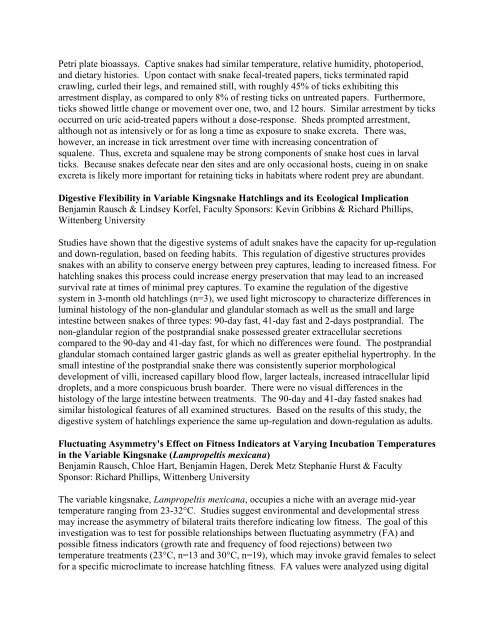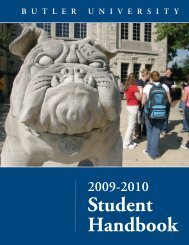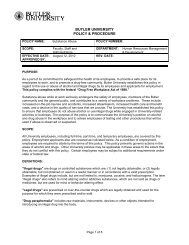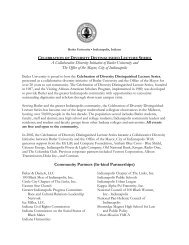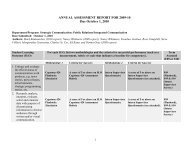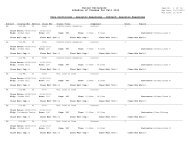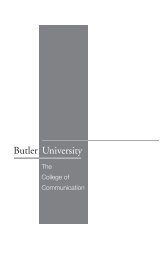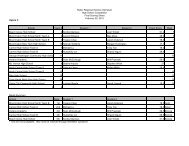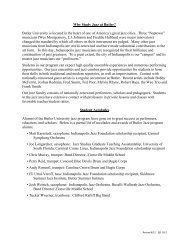Anthropology - Butler University
Anthropology - Butler University
Anthropology - Butler University
You also want an ePaper? Increase the reach of your titles
YUMPU automatically turns print PDFs into web optimized ePapers that Google loves.
Petri plate bioassays. Captive snakes had similar temperature, relative humidity, photoperiod,<br />
and dietary histories. Upon contact with snake fecal-treated papers, ticks terminated rapid<br />
crawling, curled their legs, and remained still, with roughly 45% of ticks exhibiting this<br />
arrestment display, as compared to only 8% of resting ticks on untreated papers. Furthermore,<br />
ticks showed little change or movement over one, two, and 12 hours. Similar arrestment by ticks<br />
occurred on uric acid-treated papers without a dose-response. Sheds prompted arrestment,<br />
although not as intensively or for as long a time as exposure to snake excreta. There was,<br />
however, an increase in tick arrestment over time with increasing concentration of<br />
squalene. Thus, excreta and squalene may be strong components of snake host cues in larval<br />
ticks. Because snakes defecate near den sites and are only occasional hosts, cueing in on snake<br />
excreta is likely more important for retaining ticks in habitats where rodent prey are abundant.<br />
Digestive Flexibility in Variable Kingsnake Hatchlings and its Ecological Implication<br />
Benjamin Rausch & Lindsey Korfel, Faculty Sponsors: Kevin Gribbins & Richard Phillips,<br />
Wittenberg <strong>University</strong><br />
Studies have shown that the digestive systems of adult snakes have the capacity for up-regulation<br />
and down-regulation, based on feeding habits. This regulation of digestive structures provides<br />
snakes with an ability to conserve energy between prey captures, leading to increased fitness. For<br />
hatchling snakes this process could increase energy preservation that may lead to an increased<br />
survival rate at times of minimal prey captures. To examine the regulation of the digestive<br />
system in 3-month old hatchlings (n=3), we used light microscopy to characterize differences in<br />
luminal histology of the non-glandular and glandular stomach as well as the small and large<br />
intestine between snakes of three types: 90-day fast, 41-day fast and 2-days postprandial. The<br />
non-glandular region of the postprandial snake possessed greater extracellular secretions<br />
compared to the 90-day and 41-day fast, for which no differences were found. The postprandial<br />
glandular stomach contained larger gastric glands as well as greater epithelial hypertrophy. In the<br />
small intestine of the postprandial snake there was consistently superior morphological<br />
development of villi, increased capillary blood flow, larger lacteals, increased intracellular lipid<br />
droplets, and a more conspicuous brush boarder. There were no visual differences in the<br />
histology of the large intestine between treatments. The 90-day and 41-day fasted snakes had<br />
similar histological features of all examined structures. Based on the results of this study, the<br />
digestive system of hatchlings experience the same up-regulation and down-regulation as adults.<br />
Fluctuating Asymmetry's Effect on Fitness Indicators at Varying Incubation Temperatures<br />
in the Variable Kingsnake (Lampropeltis mexicana)<br />
Benjamin Rausch, Chloe Hart, Benjamin Hagen, Derek Metz Stephanie Hurst & Faculty<br />
Sponsor: Richard Phillips, Wittenberg <strong>University</strong><br />
The variable kingsnake, Lampropeltis mexicana, occupies a niche with an average mid-year<br />
temperature ranging from 23-32°C. Studies suggest environmental and developmental stress<br />
may increase the asymmetry of bilateral traits therefore indicating low fitness. The goal of this<br />
investigation was to test for possible relationships between fluctuating asymmetry (FA) and<br />
possible fitness indicators (growth rate and frequency of food rejections) between two<br />
temperature treatments (23°C, n=13 and 30°C, n=19), which may invoke gravid females to select<br />
for a specific microclimate to increase hatchling fitness. FA values were analyzed using digital


